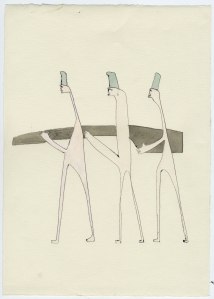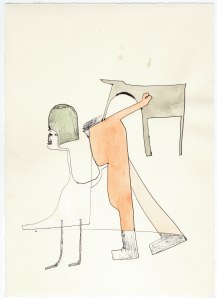“And now he was playing, alas, the piano,” the first sentence of Robert Walser’s short prose text written in 1925, “making it sound like a deep and intimate promise, which isn’t at all the way to start a novel.” An absence of pianos throughout Daniel Blumberg’s On&On&Onetc, the title of which has the potential to be as long or longer than the famous word invented by James Joyce in Finnegans Wake to sound out the catastrophic fall of a once wallstrait oldparr, makes it easier to enter its world of cords and fibres. Songs, it could be said, were invented to exclude the sound of rooms. They formulate an enclosed world. In the same way that a line of a drawing immediately proposes a hierarchy between mark and ground, the scrape of a string announces itself as the most compelling of airs within a room. At that moment, it hovers between room and song.
I hear a room, its air and the disturbances that ricochet between its surfaces, then I hear a song, as if a ship has slowly emerged out of sea mist, its form coalescing into coherent shape for the sake of memory. Doors open and close. At a given moment of life, songs may come to seem silly, Daniel muses, but then a song comes along, a country song perhaps, to articulate that cluster of emotions indelible within loss, fatigue of the spirit, a faltering of life. The song sounds a deep and intimate promise, to be fulfilled or honoured. If we go back in history, then air, or ayre, or aria, was a term through which a certain kind of musical style or accompanied song was known. To go back to Dowland, for example, or Purcell, and hear the febrile physicality of plucked and bowed strings in close wood-lined rooms. In the absence of pianos, On&On is characterised by a similar stringy physicality, reminiscent of chicken feet, a spider’s web, loosely woven fabric or grasses moving in a breeze, fibrous ligaments, claws and sand, insect stridulation, Violin, cello, bass, guitar. Then there are drums, like rats running over an unbrushed floor, disturbing matchboxes and loose quantities of steel shot in the haste of their purpose to avoid a snare. Behind the snare drum’s head there are strings, steel now, once fibrous.
There are wet cords of voice and dry cords of string; then a harmonica, filleted air bent out of shape by thin brass tongues not unlike the tongues of geese or swans. All of these instruments share an ancestry in their parts. Robert Walser argued that horses are unduly put to work, having no voice with which to express dissent. Similarly, fragments of cat, tree, goat, calf, elephant, bamboo and other entities were once unduly put to work in the service of music, unable, as Walser put it, to negotiate. Some of this unbalanced relationship, its intensity and violence, persists in the music as an echo, a dry echo, a whistle of friction that might be a ghost in the dark. Then there are other strings, collectively played in concert, as if a window has opened and the song also rises on thermals and cloud shapes.
There is no speaking about where a song begins or ends, says Ute Kanngiesser. It’s not important. A song may move around, expand, come apart in its limbs and joints and skin to sink back into the room space, where strings are vibrating, snares rattling. A string is a line drawn taut. Ute speaks about the sessions in Wales during which this record was produced: “A strong memory is of me spending what remained of the night on the porch and watching the lunar eclipse. January 2019. It was the wolf moon and the super moon and the blood moon and it was eclipsing. I watched the moon getting darker, a sepia colour, and the moment it disappeared completely, the owls started a choir from the forest. It was incredible.”
A string is a kind of line, and just as a string may become a song so a line may become a curious figure, displaced head, limbs, face and brightly coloured clothes, all bent, scattered and tumbling in air space. Like the ghost notes of a country shuffle, they fall in and out of worlds. “If I sit at the piano or I’m on the motorbike, I hum songs,” says Daniel. Between improvisation that comes into being in a room and songs that have come into being on a motorbike, there is another music, waiting for its cue in the forest. A song may come and go, on and on and on and on.
Written for the release of Daniel Blumberg’s LP: On & On (released July 31st, 2020)





I’m still trying to decide if I like Daniel Blumberg’s music;- ‘a string is a kind of line’ you write – and it might be an ‘enclosed world’, but it is engaging, inventive and peculiarly meditative. Pleased to find you plugging a new release.